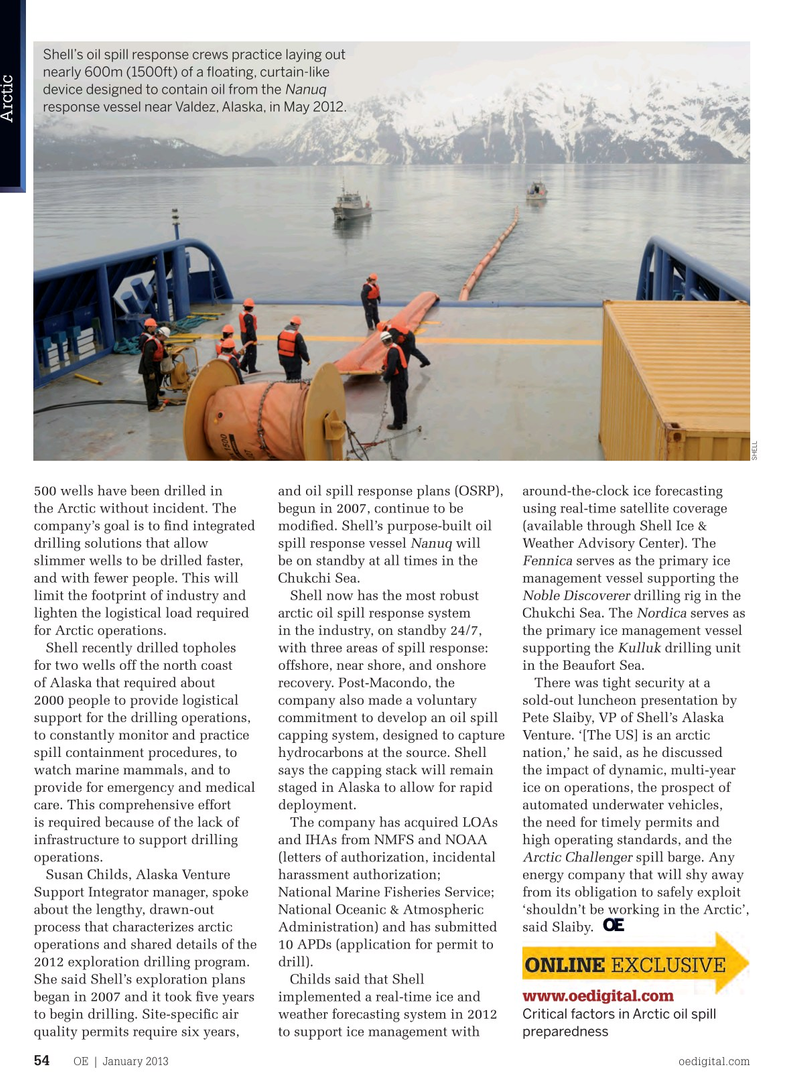
Page 52: of Offshore Engineer Magazine (Jan/Feb 2013)
Read this page in Pdf, Flash or Html5 edition of Jan/Feb 2013 Offshore Engineer Magazine
Shell’s oil spill response crews practice laying out nearly 600m (1500ft) of a ? oating, curtain-like device designed to contain oil from the
Nanuq response vessel near Valdez, Alaska, in May 2012.
Arctic
SHELL 500 wells have been drilled in and oil spill response plans (OSRP), around-the-clock ice forecasting the Arctic without incident. The begun in 2007, continue to be using real-time satellite coverage company’s goal is to ? nd integrated modi? ed. Shell’s purpose-built oil (available through Shell Ice & drilling solutions that allow will spill response vessel Weather Advisory Center). The
Nanuq slimmer wells to be drilled faster, be on standby at all times in the serves as the primary ice
Fennica and with fewer people. This will Chukchi Sea. management vessel supporting the limit the footprint of industry and Shell now has the most robust drilling rig in the
Noble Discoverer lighten the logistical load required arctic oil spill response system Chukchi Sea. The serves as
Nordica for Arctic operations. in the industry, on standby 24/7, the primary ice management vessel Shell recently drilled topholes with three areas of spill response: supporting the drilling unit
Kulluk for two wells off the north coast offshore, near shore, and onshore in the Beaufort Sea.
of Alaska that required about recovery. Post-Macondo, the There was tight security at a 2000 people to provide logistical company also made a voluntary sold-out luncheon presentation by support for the drilling operations, commitment to develop an oil spill Pete Slaiby, VP of Shell’s Alaska to constantly monitor and practice capping system, designed to capture Venture. ‘[The US] is an arctic spill containment procedures, to hydrocarbons at the source. Shell nation,’ he said, as he discussed watch marine mammals, and to says the capping stack will remain the impact of dynamic, multi-year provide for emergency and medical staged in Alaska to allow for rapid ice on operations, the prospect of care. This comprehensive effort deployment. automated underwater vehicles, is required because of the lack of The company has acquired LOAs the need for timely permits and infrastructure to support drilling and IHAs from NMFS and NOAA high operating standards, and the operations. (letters of authorization, incidental spill barge. Any
Arctic Challenger Susan Childs, Alaska Venture harassment authorization; energy company that will shy away
Support Integrator manager, spoke National Marine Fisheries Service; from its obligation to safely exploit about the lengthy, drawn-out National Oceanic & Atmospheric ‘shouldn’t be working in the Arctic’, process that characterizes arctic Administration) and has submitted said Slaiby.said Slaiby.
operations and shared details of the 10 APDs (application for permit to 2012 exploration drilling program. drill).
She said Shell’s exploration plans Childs said that Shell began in 2007 and it took ? ve years implemented a real-time ice and www.oedigital.comwww.oedigital.com to begin drilling. Site-speci? c air weather forecasting system in 2012 Critical factors in Arctic oil spill quality permits require six years, to support ice management with preparedness
OE | January 2013 oedigital.com 54 oe_ArcticTech.indd 54 03/01/2013 13:42

 51
51

 53
53